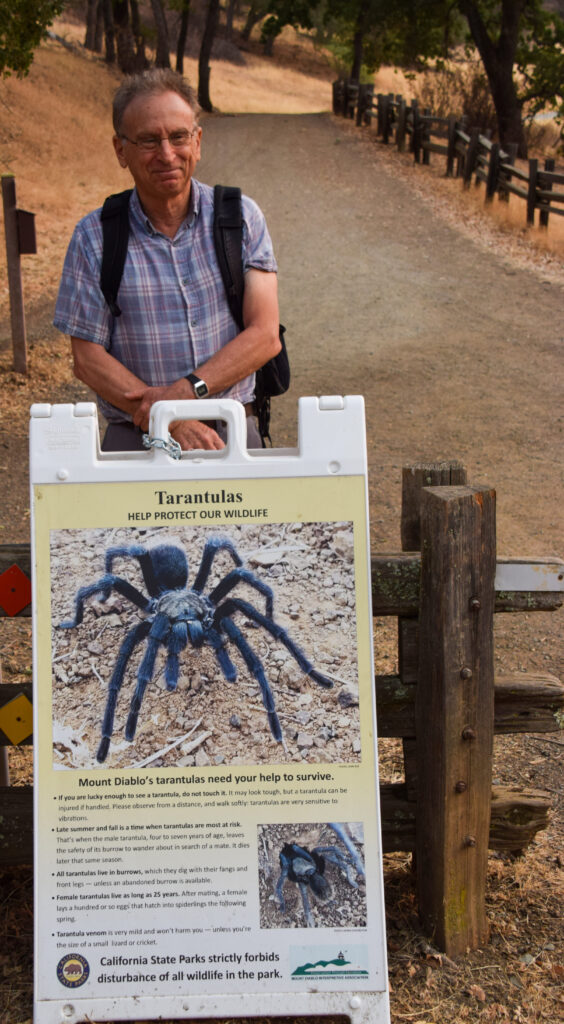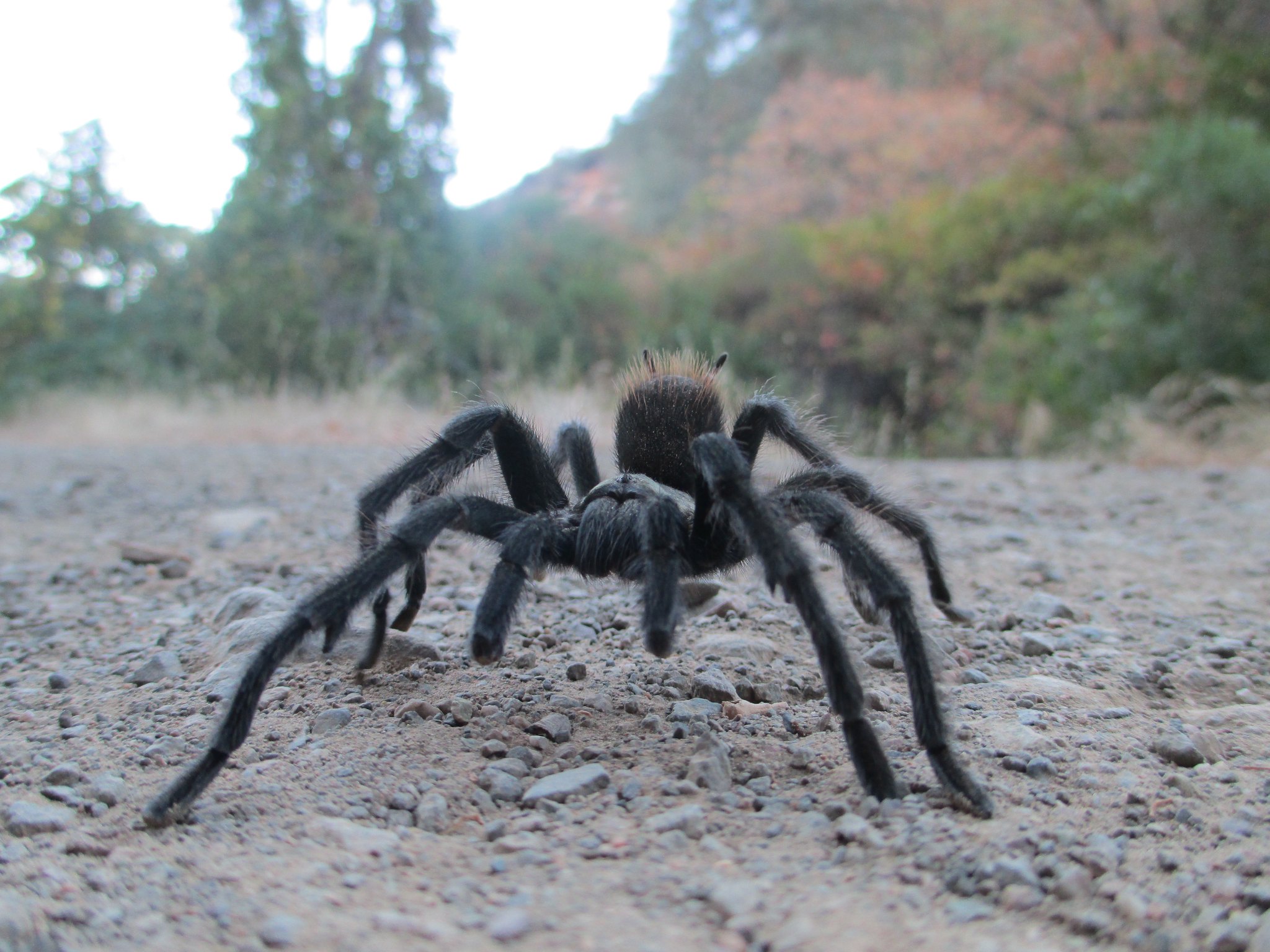By Jill Hedgecock
They are big, hairy, and while many people have nightmares about encountering one, I bubbled over with excitement at the prospect of going on an evening hike searching for tarantulas. It is the time of year that male tarantulas emerge from underground in search of a mate. Between late August through the first week of October, Mount Diablo is a great place to go observe these fascinating creatures firsthand, and the experience is even better if you can go on a scheduled hike with a tarantula expert.

Photo by Diane Walsh
On August 19th, naturalists Ken Lavin and Liz Watson, who lead tarantula hikes through the Mount Diablo Interpretive Center, met with photographer Diane Walsh, my husband, Eric, and me. We assembled at a picnic table near the main parking lot at Mitchell Canyon, a popular place to track down these giant arachnids, to learn more about the behavior and biology of these fascinating creatures before we departed on our scheduled hike to look for roaming males.
Of the over 850 tarantula species worldwide, only 18 species are known to inhabit California. The most common species in the Bay area is one of the desert tarantula species, Aphonopelma iodius.
After Lavin regaled us with historical stories about a pioneering geologist who found a tarantula in his boot and described some of his favorite tarantula movies, he plucked a giant plastic tarantula out of his tutorial box and described the unique traits of these amazing spiders.
“They have exoskeletons,” said Lavin. “They are growing on the inside, but their skeleton is not growing, so eventually it’s very uncomfortable. They will lie on their back, pump up their blood pressure into their abdomen (spiders have only two body parts, not three like insects) and pull themselves out of the outer shell, which is called the carapace. They will have new legs, new fangs, new stomach lining, new lungs, and the female will have new lady parts. For a few days, they will be very vulnerable. They’re soft until they harden.”
He passed around an old carapace he uses for teaching and pointed out the fangs.
“Their fangs are fixed in place,” Lavin said. “They have to rear up and strike down. So you have plenty of warning.”
Female tarantulas stay in their burrows most of their lives and can live to be 25 years old. Males are not so lucky with a life span of only 7 to 8 years. The only way to tell the sex of one, other than where you find them since only males wander far from their burrows, is after the male’s final molt. Then he will have hooks on the underside of their front legs, called pedipalps, that keep the female’s fangs away from him during mating.
“Aphonopelma means silent sole—as in sole of the foot,” explained Lavin, who grew interested in tarantulas after he saw them hiking. He has been a fan for about 20 years now. “You kind of cringe when you first see them if you’re not used to them,” said Lavin. “I got interested in the historical aspect.”
Watson’s interest in tarantulas arose for a very different reason. “They are very sweet, docile creatures,” Watson said, “and just misunderstood. I like to explain to people that these are very, cool creatures.”
“She likes to terrorize her school,” Ken added, and laughed. “She has the teacher’s lounge to herself.”
Watson is right about being misunderstood. Myths abound about tarantulas. One of the most common is that a tarantula bite is fatal. But there have been no documented cases of human deaths from tarantula bites. While a wound caused by their long, fangs may be unpleasant, their weak venom is not strong enough to take out a human. It is possible, though extremely unlikely, if a bite goes untreated, that a person could develop complications like gangrene and die, but a quick trip to the doctor will prevent that.
Humans are also generally unaffected by the tarantula’s main defense against its predators, the special hairs, called urticating hairs, located on their abdomens. Tiny barbs on them irritate the skin or injure their foe’s eyes. For some birds, small mammals, and snakes, these hairs can sometimes cause severe injury.
Another popular misconception is that tarantulas are aggressive and will jump 5 to 10 feet in the air to attack you. First, tarantulas are not aggressive to humans unless mishandled. Second, a jump of several feet would cause internal organ damage and kill the spider. Third, tarantulas have poor vision and cannot see much besides shadows. They depend on the silk that covers the ground in and around their burrows to send a vibration to identify their prey.
The common myth that the female eats the male after mating is also not true. Males have a slow demise after mating. Once they leave their burrows, males do not have access to food and will slowly starve, so the female has nothing to do with their death.
Some believe tarantulas are miniature vampires hell-bent on sucking your blood. No. The diet of these hairy creatures is primarily grasshoppers, beetles, other small spiders and arthropods, but they will sometimes eat small lizards.
They have an interesting digestive system which involves vomiting on their food to liquify it. Its stomach can expand and contract so that it can suck up liquids like a vacuum cleaner. When a tarantula gorges itself, it breaks down the food into liquids and stores it in an elaborate system of sacs and pouches throughout the body, allowing it to go for several days without eating again.

So why are these gentle creatures so maligned? Hollywood can share a good deal of the blame. Spider-centric horror flicks like “Tarantula!” (1955), “The Incredible Shrinking Man” (1957), “Tarantulas: The Deadly Cargo” (1977), “Kingdom of the Spiders” (1977), “Something Wicked This Way Comes” (1983), “Arachnophobia” and “Home Alone” (both released in 1990) are a few movies that depict these animals as vicious, blood-thirsty scary creatures. The poster for “Tarantula!” shows a two-eyed, rather than 8-eyed, spider showing how little Hollywood understands these maligned creatures.
Liz Watson brought her pet rose hair tarantula, Scarlett O’Harry, so we got to meet and hold one of these furry spiders firsthand. They are surprisingly light weight. While I was not afraid, the crawling legs made me a little ticklish.
“Pet spiders aren’t lonely,” says Lavin, who also keeps one as a pet. “If another one was introduced, she’d probably kill it.”
Both said their most memorable tarantula experience was when they were on a hike and captured a pair mating on video. While hundreds of fertilized eggs will hatch after mating, Watson explained, only a few will live into adulthood.
humans are a major threat to the species, mostly due to habitat destruction. Natural predators include lizards, snakes, skunks, coyote, foxes, and birds such as hawks and roadrunners are known to eat them. One of their biggest enemies are parasites such as the tarantula hawk wasp. This large wasp stings the spider to paralyze it, lays eggs on it and seals it into a burrow. When the wasp larva hatches, it eats the tarantula. Fortunately, wildfires do not kill these underground dwellers.
Lavin warned not to capture one and keep it as a pet. You will be investing in a terrarium, food and other necessities, only to have the mature males die in a few months. It is much better to purchase one from a pet store.
It is rare for tarantulas to invade homes or garages, but they can be found floating in pools. If you do find one around your house, Lavin advises to have it walk into a cup and let it go. If you find one in your pool, fish it out, and it will walk away.
“They can survive in flooded burrows for days,” says Lavin. “They have such a slow metabolism.”
These normally nocturnal creatures are elusive, but the males appear predictably during early evening hours of their mating season.
However, with the warming climate, insects are emerging earlier in the year and the males are growing and molting faster. October used to be prime time, but now the lovelorn males are coming out as early as late August. Throw in drought conditions and tarantula sightings become even more unpredictable. Alas, our quest was too early in the season, so we did not see any wandering males during our hike, but we had the pleasure of seeing their burrows.
Lavin and Watson are offering tarantula hikes on Saturday, September 4th and 18th from 5 to 7:30 pm. Space is limited, and they are currently full, but you can check mdia.org for cancellations. You can also hike along the trail by yourself. You may just get lucky. It is important to avoid picking up a wild tarantula as they are quite fragile and a fall of even a few inches can damage their internal organs.
The Lindsay Wildlife Museum also offers tarantula hikes on Sundays, September 19th and 26th, from 5 to 7 pm. On October 3rd and 10th, they will be held from 4:45 to 6:45 pm. The Lindsay Museum hikes cost $15 and $20 for members and nonmembers, respectively. There is an additional $6 fee to park at Mitchell Canyon.

